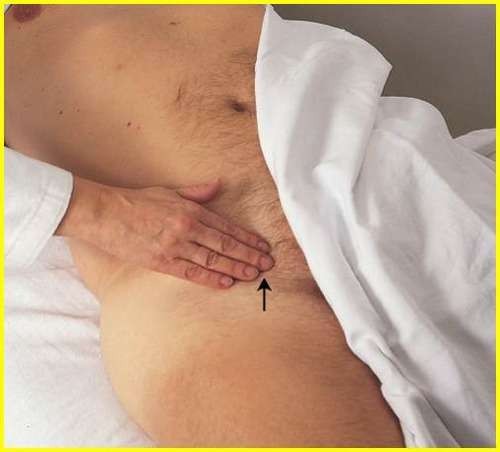A nurse is caring for an infant who has coarctation of the aorta.
Which of the following should the nurse identify as an expected finding?
Frequent nosebleeds.
Upper extremity hypotension.
Weak femoral pulses.
Increased intracranial pressure.
The Correct Answer is C

This is because coarctation of the aorta is a congenital condition where the aorta is narrow, usually in the area where the ductus arteriosus inserts. This causes a decrease in blood flow to the lower body, resulting in weak or absent pulses in the femoral arteries.
The other choices are incorrect for the following reasons:
Choice A is not a typical sign of coarctation of the aorta.
Nosebleeds can be caused by many factors, such as dry air, allergies, trauma, or bleeding disorders.
Choice B is also not a common finding in coarctation of the aorta. In fact, patients with this condition may have high blood pressure in the upper extremities due to the increased resistance of the narrowed aorta.
Choice D is not directly related to coarctation of the aorta.
Increased intracranial pressure can be caused by various conditions that affect the brain, such as head injury, stroke, infection, or tumor.
Normal ranges for blood pressure and pulse vary depending on age, sex, and health status. However, some general guidelines are:
- Blood pressure: less than 120/80 mmHg for adults; less than 95/65 mmHg for infants.
- Pulse: 60 to 100 beats per minute for adults; 100 to 160 beats per minute for infants.
Nursing Test Bank
Naxlex Comprehensive Predictor Exams
Related Questions
Correct Answer is ["C","E"]
Explanation
A urine culture is indicated for the client who has lower back pain and pinkish vaginal discharge, as these symptoms may suggest a urinary tract infection (UTI). A urine culture can identify the causative organism and guide the appropriate antibiotic therapy.
Phenazopyridine is a urinary analgesic that can relieve pain, burning, and urgency associated with a UTI. However, it requires a provider prescription and should not be used for more than two days.
A vaginal culture is not necessary for this client, as the vaginal discharge is likely due to the cervical changes during labor. A vaginal culture may be indicated for clients who have signs of vaginitis, such as itching, odor, or abnormal color of the discharge.
Obtaining a provider prescription for antibiotics is premature for this client, as the urine culture results are not available yet. Antibiotics should be prescribed based on the sensitivity of the organism causing the UTI.
Ibuprofen 600 mg every 6 hr for mild to moderate pain is not appropriate for this client, as it may interfere with uterine contractions and prolong labor. Ibuprofen is also contraindicated in the third trimester of pregnancy due to the risk of premature closure of the ductus arteriosus in the fetus. The nurse should use nonpharmacological methods to relieve the client’s back pain, such as massage, heat, or position changes.
Correct Answer is A
Explanation
This is because collaboration is one of the most effective conflict-resolution strategies in nursing, as it involves finding a mutually beneficial solution that satisfies both parties and improves the quality of care. Collaboration can also foster trust, respect, and teamwork among nurses, which can boost morale and efficiency.
Choice B is wrong because telling the nurses that the assignments will be more equitable in the future does not address the root cause of the conflict or involve the nurses in the decision-making process.
It also implies that the charge nurse admits to being unfair, which can damage their credibility and authority.
Choice C is wrong because asking each nurse to take turns making the assignments does not resolve the conflict, but rather avoids it. Avoidance is one of the least effective conflict management strategies in nursing, as it results in not addressing the issue or finding common ground.
Avoidance can also lead to resentment, frustration, and poor communication among nurses.
Choice D is wrong because arranging for the nurses to have as few shifts together as possible also does not resolve the conflict, but rather accommodates it. Accommodation is another ineffective conflict management strategy in nursing, as it involves giving in to one party’s demands or preferences at the expense of another’s.
Accommodation can also create a sense of inequality, injustice, and dissatisfaction among nurses.
Normal ranges for conflict-resolution strategies in nursing are not applicable, as different situations may require different approaches. However, some general guidelines are to use collaboration when both parties have important goals or interests, compromise when both parties have some common ground or willingness to give up something, competition when one party has a clear advantage or authority, avoidance when the conflict is trivial or temporary, and accommodation when one party values harmony or relationships more than their own goals or interests.
Whether you are a student looking to ace your exams or a practicing nurse seeking to enhance your expertise , our nursing education contents will empower you with the confidence and competence to make a difference in the lives of patients and become a respected leader in the healthcare field.
Visit Naxlex, invest in your future and unlock endless possibilities with our unparalleled nursing education contents today
Report Wrong Answer on the Current Question
Do you disagree with the answer? If yes, what is your expected answer? Explain.
Kindly be descriptive with the issue you are facing.
